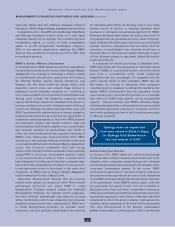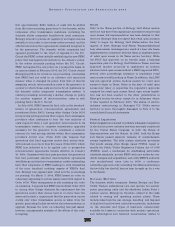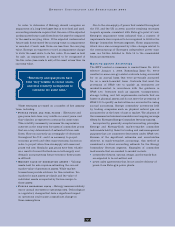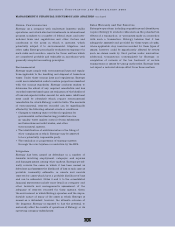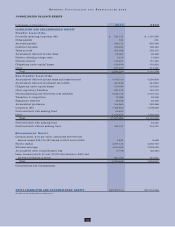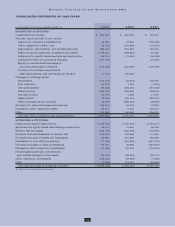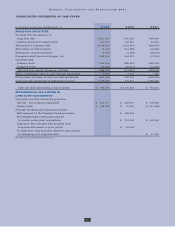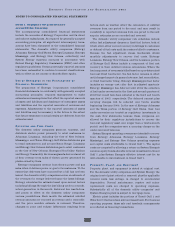Entergy 2003 Annual Report Download - page 48
Download and view the complete annual report
Please find page 48 of the 2003 Entergy annual report below. You can navigate through the pages in the report by either clicking on the pages listed below, or by using the keyword search tool below to find specific information within the annual report.
46
ENTERGY CORPORATION AND SUBSIDIARIES 2003
Conversely, commodity contracts that are not considered
derivatives, generally because they involve physical
delivery of a commodity to the purchaser, are not marked
to market. Examples of commodity contracts that are
not marked to market include:
the PPAs for Entergy’s Non-Utility Nuclear plants;
capacity purchases and sales by the U.S. Utility
companies; and
forward contracts that will result in physical delivery.
Fair value estimates of the commodity instruments that
are marked to market are made at discrete points in time
based on relevant market information. Market quotes are
used in determining fair value whenever they are available.
When market quotes are not available (e.g., long-dated
commodity contract), other information is used, including
transactional data and internally developed models. Fair
value estimates based on these other methodologies are
necessarily subjective in nature and involve uncertainties
and matters of significant judgment. These uncertainties
include projections of macroeconomic trends and future
commodity prices, including supply and demand levels and
future price volatility. The impact of these uncertainties,
however, is lessened by the relatively short-term nature of
the mark-to-market positions held by Entergy and EKT.
PENSION AND OTHER POSTRETIREMENT BENEFITS
Entergy sponsors defined benefit pension plans which
cover substantially all employees. Additionally, Entergy
provides postretirement health care and life insurance
benefits for substantially all employees who reach retirement
age while still working for Entergy. Entergy’s reported costs
of providing these benefits, as described in Note 11 to the
consolidated financial statements, are impacted by numerous
factors including the provisions of the plans, changing
employee demographics and various actuarial calculations,
assumptions, and accounting mechanisms. Because of the
complexity of these calculations, the long-term nature of
these obligations, and the importance of the assumptions
utilized, Entergy’s estimate of these costs is a critical
accounting estimate for the U.S. Utility and Non-Utility
Nuclear segments.
Assumptions
Key actuarial assumptions utilized in determining these
costs include:
Discount rates used in determining the future benefit
obligations;
Projected health care cost trend rates;
Expected long-term rate of return on plan assets; and
Rate of increase in future compensation levels.
Entergy reviews these assumptions on an annual basis
and adjusts them as necessary. The falling interest rate
environment and poor performance of the financial equity
markets over the past several years have impacted
Entergy’s funding and reported costs for these benefits. In
addition, these trends have caused Entergy to make a
number of adjustments to its assumptions.
In selecting an assumed discount rate, Entergy reviews
market yields on high-quality corporate debt. Based on
recent market trends, Entergy reduced its discount rate
from 7.5% in 2001 and 6.75% in 2002 to 6.25% in 2003.
Entergy reviews actual recent cost trends and projected
future trends in establishing health care cost trend rates.
Based on this review, Entergy increased its health care cost
trend rate assumption used in calculating the 2003
accumulated postretirement benefit obligation. The assumed
health care cost trend rate is a 10% increase in health care
costs in 2004 gradually decreasing each successive year
until it reaches a 4.5% annual increase in health care costs
in 2010 and beyond.
In determining its expected long-term rate of return on
plan assets, Entergy reviews past long-term performance,
asset allocations, and long-term inflation assumptions.
Entergy targets an asset allocation for its pension plan
assets of roughly 66% equity securities, 30% fixed income
securities, and 4% other investments. The target allocation
for Entergy’s other postretirement benefit assets is
45% equity securities and 55% fixed income securities.
Based on recent market trends, Entergy decreased its
expected long-term rate of return on plan assets from 9% in
2001 to 8.75% for 2002 and 2003. The trend of reduced
inflation caused Entergy to reduce its assumed rate of
increase in future compensation levels from 4.6% in 2001 to
3.25% in 2002 and 2003.
Cost Sensitivity
The following chart reflects the sensitivity of pension cost
to changes in certain actuarial assumptions (in thousands):
Actuarial Change in Impact on 2003 Impact on Projected
Assumption Assumption Pension Cost Benefit Obligation
Increase/(Decrease)
Discount rate (0.25%) $4,882 $83,651
Rate of return
on plan assets (0.25%) $4,346 –
Rate of increase
in compensation 0.25% $4,039 $ 28,101
MANAGEMENT’S FINANCIAL DISCUSSION AND ANALYSIS
continued






